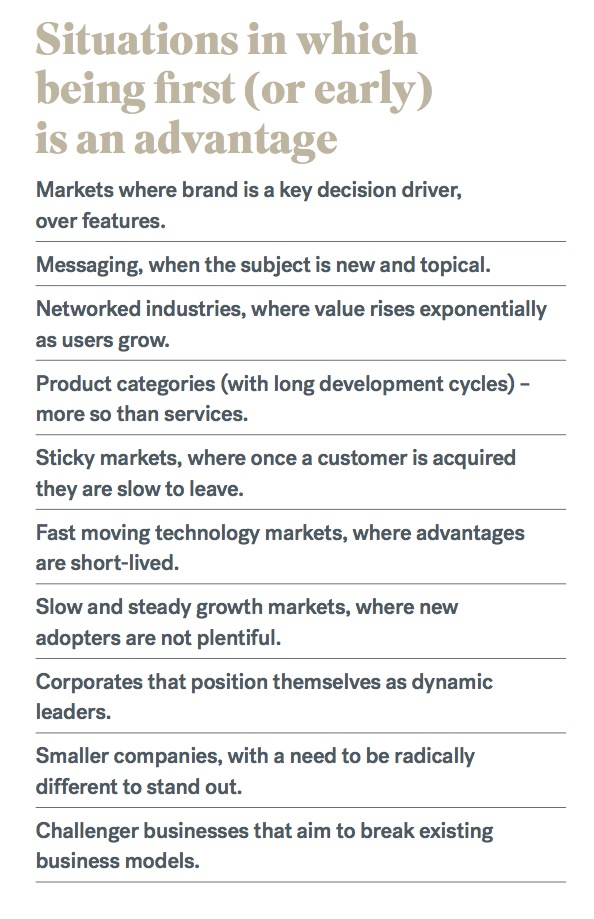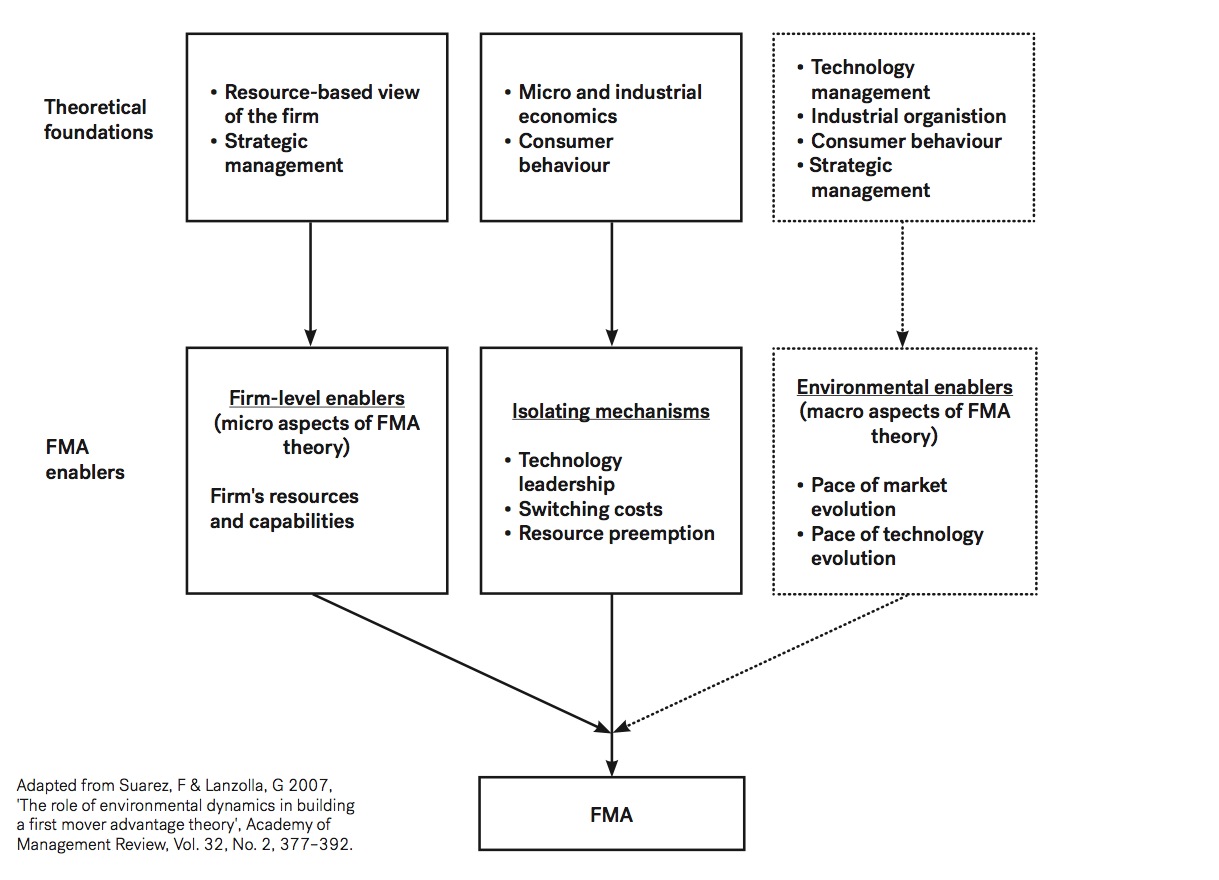First in, best dressed? The dubious nature of first-mover advantage
Share
Few business maxims are as widely known as first-mover advantage, despite patchy evidence of its merits. Rob Grant examines when marketers should bravely lead from the front and when it pays to sit in the slipstream.
Humans love to be first. It’s a seductive, hard-wired notion and the era of social media brings it the fore. Every minute, of every day, people claim bragging rights to everything. First to see the latest Hollywood blockbuster. Ownership of the newest smartphone ahead of their friends. The discovery of a new, exclusive, back-alley bar.
It’s no surprise then that so many businesses strive to be leaders in their markets. Innovation is the cornerstone of most strategic plans and there is an implicit understanding that being first is crucial. But is it?
 Swings and roundabouts
Swings and roundabouts
First mover innovators are heralded in the business press and presented as case studies of marketing excellence. Rivals look on as they reap new revenue streams and steal customers with their shiny new offerings. They are believed to quickly command market share that is difficult to chase.
Al Crawford, executive planning director at Clemenger BBDO, believes that in the right circumstances being first is a big advantage. “It can give you a huge amount of volume that won’t be achieved by people coming in second or third. For a time, you become the default choice,” he says.
By launching early, companies can learn, iterate and, if necessary, move onto the next thing. The only danger is when competitors learn too. Proceed quickly through the development of new ideas and your team members and capital are not tied up for too long.
Chris Ball works at BlueChilli, where he helps major brands learn from and work with fast-moving start-ups. He feels speed of execution is one area in which big brands can do much better.
Ball explains, “If you’re going to fail, you want to fail fast. If you’re going to win and do well, you want to do that as fast as you can and grow as quickly as you can grow.”
Yet, ask anyone to think about first mover advantage and they will immediately cite classic examples of leaders usurped by better or bigger followers. Google eclipsed Alta-Vista and Ask Jeeves. VHS dominated Betamax. Apple’s iPod made a mockery of existing MP3 players.
In a sense, the linear notion of new ideas being first, then second, then third… is a little redundant. Every new innovation is different, at least subtly, and has potential to unlock value in a different way.
Michael Priddis, managing director of BCG Digital Ventures, consults on innovation to large corporates and thinks there’s an implied problem with first mover advantage. “There is an assumption of a finite amount of demand or revenue. I think the lesson of the last 10 years is that there’s almost an infinite ability to innovate and to create new products and services. Standout brands identify a new need or new customer opportunity and address it in ways others have not,” he says.
Even academics are inconclusive on the topic. A total of 839 journal articles on the topic were reviewed in the Academy of Management Review (Suarez and Lanzolla, 2007) and no clear answer emerged. Existence of an advantage, a correlation between order of entry and measures such as market share, could neither be supported nor refuted.
Click image to enlarge.
Peter Murmann, professor of strategic management at UNSW Business School, agrees it’s a topic fraught with uncertainty. “Is there such a thing as competitive advantage? The answer is not clear that there really is an advantage across all industrial settings. It is not always the first mover that really takes the prize,” he says.
It’s hard to even know who is first and who follows. Innovation – like music trends or fashion styles – often brings together the best elements of products and services already in existence. Entirely new ideas are rare, if they exist at all. In many cases, the so-called first mover is just the brand that becomes most widely known for a new idea, rather than a genuine inventor in the classic sense.
A more useful way to think of speed-to-market is as a scale, rather than a binary case of first or not. In many circumstances, the fast followers, early movers or even late entrants are the brands that thrive. Just don’t be last.
If the question is ‘does first mover advantage exist?’ then the answer is a somewhat frustrating ‘it depends’. So marketers need to understand the factors that influence the importance of speed to market in order to determine their strategy.
As with most challenges in marketing, it requires a deep understanding of the brand you manage, the market you play in and the company you work for. In many cases, the driving factors are counterintuitive, the opposite of what one might assume.
Bring it back the brand
 Beyond the obvious revenue benefits of early-to-market innovation, arguably the richest bounty lies in the benefits to the brand. Clearly it’s important not just to be first, but to establish strong awareness of your new offering. Consumers will then typically choose market leaders simply because they are the best-known choice. Crawford thinks brand salience is a major driver of purchase and being first helps establish a presence. “If you are first, you can become the default choice in the category. The first brand is more likely to be salient and more likely to be bought as a result,” he says.
Beyond the obvious revenue benefits of early-to-market innovation, arguably the richest bounty lies in the benefits to the brand. Clearly it’s important not just to be first, but to establish strong awareness of your new offering. Consumers will then typically choose market leaders simply because they are the best-known choice. Crawford thinks brand salience is a major driver of purchase and being first helps establish a presence. “If you are first, you can become the default choice in the category. The first brand is more likely to be salient and more likely to be bought as a result,” he says.
Brands can own new ideas for longer, and so create a durable advantage, when brand itself is more important than rational product features in the decision-making process. If a brand can emotionally own a new territory, it’s hard to copy. Murmann explains, “There’s strong evidence that when a brand is an integral part of making the decision, moving earlier rather than later matters. If you move too late, somebody else will have established a brand around that idea. It will be hard for you to move in.”
For brands, being first is not just about products and services. The first brand to own a particular message or product claim can render the promise useless to competitors. Provided when they broadcast they go out big. Recently in Australia, the hormone-free beef campaign by Coles was a good example. Once it owned this point of difference, a competitor copying with the same promise would seem like a fake. Crawford explains that this advertising practice dates far back. “In America, in the early 20th century, there was a beer that said, ‘all our bottles are washed with steam’. As it happens, everybody’s bottles were washed with steam. In markets where there is lots of parity, being first to say something matters,” he says.
Marketers in brand-driven categories must be first-to-market or close behind any leading competitor. Move too late and a rival will own the new space in the hearts and minds of the consumer. From this position, it’s hard to catch up.
Corner the market
Certain types of market – typically new and disruptive ones – demand first mover advantage. Networked industries, which connect people in some way, are the most extreme example as their value grows with a multiplier effect the more people join. Facebook, eBay and Airbnb are all good examples. Murmann explains how they benefit from being early to market. “Any time when the value of using a certain technology goes up with other people using the same technology, then early mover advantages play a greater role,” he says.
Whether you sell products or services also impacts the need for speed. Perhaps surprisingly, there is a greater need for speed if you market products, as once you establish the new offer there is reasonable time thereafter to milk the benefits. With services, you can more easily be copied overnight, especially in the digital space.
Priddis says, “Australia is principally a service economy. And when you think about service innovation versus new product build, the period of sustainable differentiation is only months. I put an app out and the next guy launches one that’s the same. It can be done very quickly.”
The stickiness of the customer relationship is another key consideration. Somewhat paradoxically, it’s more important to be fast when customers are slower to move. Priddis explains this tricky notion, “If a product is particularly sticky, like a retail bank account, then speed matters. It’s not so much being first with the product, but first with that sticky relationship. Once you’ve got a bank account, you don’t want to change it.”
Murmann expands on this idea by looking at the pace at which new consumers enter markets. “When consumers are entering the market very quickly there is no such thing as first mover advantage, because when new players enter there are new customers always arriving. On the other hand, when the adoption is slow, only the incumbent firm can grab them.”
Most would assume being first is more important in fast-moving technology markets. But the contrary is true. When new innovations occur rapidly, the advantages of being first are short-lived. Do you know who was first with LaserDiscs? It doesn’t matter, we moved on.
Get down to business
At a company level, the importance of speed to market is partly dependent upon your overall corporate strategy and culture. Ball believes the business itself can provide the impetus to be first. “How do they want to be perceived in the market? What sort of player do they want to be? Do they want to be aggressive, get out there, set the terms and be known as a brand that is innovative and a leader?” he asks.
Being seen as the leader can provide benefits, beyond revenue and market share, to relationships with suppliers and retailers, employee engagement and investor relations. Like bees to a honey pot, leading companies – large and small – tend to attract talent and funding.
Bigger companies, with their unwieldy structures, complex processes and low appetites for risk, are generally slower to innovate than smaller ones. When a large company is a significant market share leader, it also lacks the impetus to be first. With a strong distribution network, customer loyalty and brand equity, it can often copy the ideas of more agile upstarts before the newcomer commands significant market share. In some cases, they may even buy them. The Coca-Cola Company regularly adopts this approach. Powerade, Coke Zero, Mother and Barista Bros were all considerably later to market than competitors, yet they command high market share due to the might of the parent company.
“If you’re an existing company and you have the distribution network, do you want to be first mover? Probably not. You need to monitor the market very carefully and see whether the product gets enough traction. Once it does, use your existing brand, distribution network and organisational capabilities to roll out to the market,” says Murmann.
In markets where no one player commands a majority share, however, being first can separate a company from its peers. Indeed, in cases where the first mover can build significant supply chain economies of scale, the advantage may prove terminal for competitors. The first mover can offer lower prices or command greater margins.
For challenger companies the situation is a little different, though being first is still not essential. Many brands, especially start-ups that create new business models in established industries, do achieve success by stealing the mark on the big guys. Challenger brands of this type build being first into every aspect of their business approach. Dyson aims to be first in categories, from vacuum cleaners to hand dryers, which are ripe for innovation. In doing so, it leaves the incumbents gasping for breath.
Other upstarts are happy to be early movers, but ones that improve on the original or offer it in their own unique way. It’s hard to think of Google as a follower. But this is what it has consistently been, first in search engines, then in email, browsers and content services (video, music, games).
Then there are companies that will simply copy an idea and do it more cheaply, through a more efficient supply chain or distribution model. Aldi’s successful launch of a budget coffee pod machine, after Nespresso spent a fortune to establish the market, is a great example. The communication even mocks the pretensions of the originator. Crawford explains, “There are those brands that say, actually my role is to follow you, annoy you and do it more cheaply.”
For every frantic hare that wins race honours, there is a plodding tortoise that takes a little more care and steals the glory. Armed with an understanding of what drives the advantages of being first, marketers can plan the type of race they should run.
_
To compliment this feature on first-mover advantage, Marketing and its survey partner SSI polled 1000 Australians in December 2015 to ask about their views on whether they look for and purchase innovative or market leading brands. Click here to see the results.
















